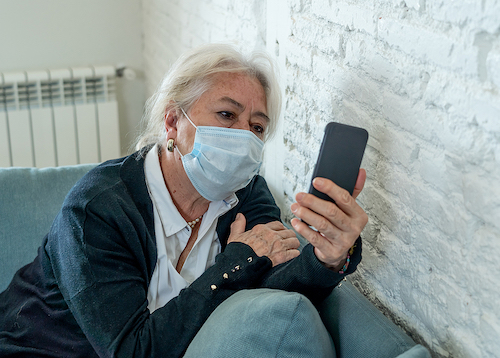 Throughout the COVID-19 pandemic, many people have experienced feelings of social isolation.
Throughout the COVID-19 pandemic, many people have experienced feelings of social isolation.
For some, interaction with others has been confined to a zoom call, for others there hasn’t been any interaction at all.
Now, researchers at MIT have found that the longing for social interaction felt whilst isolated is neurologically similar to that for food cravings when hungry.
“We found that our brains’ “motivation center” (the substantia nigra) responded in similar ways after fasting and after isolation: When people were isolated the brain region showed higher activity in response to pictures of other people (and not to food) but when they were fasted, the substantia nigra showed higher activity in response to pictures of food (and not to social pictures),” Livia Tomova, lead author of the study and a former MIT postdoctoral researcher now based at Cambridge University told Theravive.
In undertaking the research, the neuroscientists enlisted forty healthy volunteers, predominantly college students, and put each alone in a windowless room on MIT’s campus for 10 hours. The participants weren’t allowed to use their phone, but could use a computer to contact the researchers if needed.
The researchers went to great lengths to ensure the participants would feel truly isolated. Participants had to tell the researchers when they wanted to use the bathroom, and the researchers ensured the bathroom was completely empty. Food was delivered and left at the participants door, who then received a text saying it was there to ensure they didn’t see other people.
Once the 10-hour period of isolation ended, the participants were scanned using MRI. To continue the feelings of isolation, the participants had been trained in how to correctly get into the MRI machine without assistance. The participants were scanned whilst looking at images of people interacting, food and images that were meant to be neutral, like flowers.
On a different day, the 40 participants also did 10 hours of fasting. At the end of the 10 hours, the participants were scanned again, also looking at images of food, people interacting, and flowers.
The neuroscientists focused on a part of the brain called the substantia nigra, which has in the past been linked to hunger cravings as well as cravings for drugs.
“The amount of activity we found in the substantia nigra was correlated with how much people reported to want food or social contact. We then used machine learning: we trained a machine learning algorithm to identify how neural signals of a hungry person who looks at pictures of food look like. We then “showed” the algorithm brain signals of a lonely person looking at pictures of other people and asked if it could differentiate those from control signals without having “seen” those signals before. And it could! So this suggests that there is a shared neural signature between craving for food and craving for social contact,” Tomova said.
The participants’ responses to isolation was variable and dependent on their normal level of loneliness. The researchers found that those who reported feeling chronically isolated during the period before the study showed lower cravings for social contact after the 10-hour period of isolation when compared with those who said they had a rich social life in the months leading up to the study.
“There is this theory in social psychology that loneliness acts as a signal to the individual that something is lacking and that it needs to take action in order to repair what is lacking. Animal researchers also termed this the “social homeostasis model,” Tomova said.
“This means that there is an amount of social interaction that social species need in order to function properly – just like we need a certain amount of food in order to live. The idea is that if we don’t have enough social interaction, we feel lonely and are motivated to engage in more social interaction (so we “crave social interactions”) in order to reach homeostasis again.”
The findings could have important ramifications for policy makers, as more and more people are spending time in isolation due to the COVID-19 pandemic.
“In times of social distancing, we might have to pay special attention to people’s well-being and mental health if they have to spend time in isolation. While many people are with their families or stay connected over social media, not everybody has the possibility to do that. Some people live alone and/ or might have restricted access to digital technologies. Those people might experience a very extreme version of social distancing which could affect their mental health. I think it is important to pay attention to this social dimension of the current crisis as well,” Tomova said.
Elizabeth Pratt is a medical journalist and producer. Her work has appeared on Healthline, The Huffington Post, Fox News, The Australian Broadcasting Corporation, The Sydney Morning Herald, News.com.au, Escape, The Cusp and Skyscanner. You can read more of her articles here. Or learn more about Elizabeth and contact her via her LinkedIn and Twitter profiles.